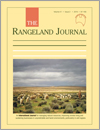RJ18081Impact of agrarian practices and some pastoral uses on vegetation in Algerian steppe rangelands
In this study we determined that increased agrarian activity (increased rangeland ploughing) and changed livestock practices (higher stocking rates) have led to heterogeneity in the pastoral vegetation of steppe rangelands in Algeria. The biophysical constraints of a given territory (in the sense of a ‘terroir’) exacerbate the major impacts of human activity on vegetation. Plant communities were stable in some areas, whereas regressive successions were observed in others. The difference between these situations was clearly linked to grazing conditions and the proximity of ploughed land.





